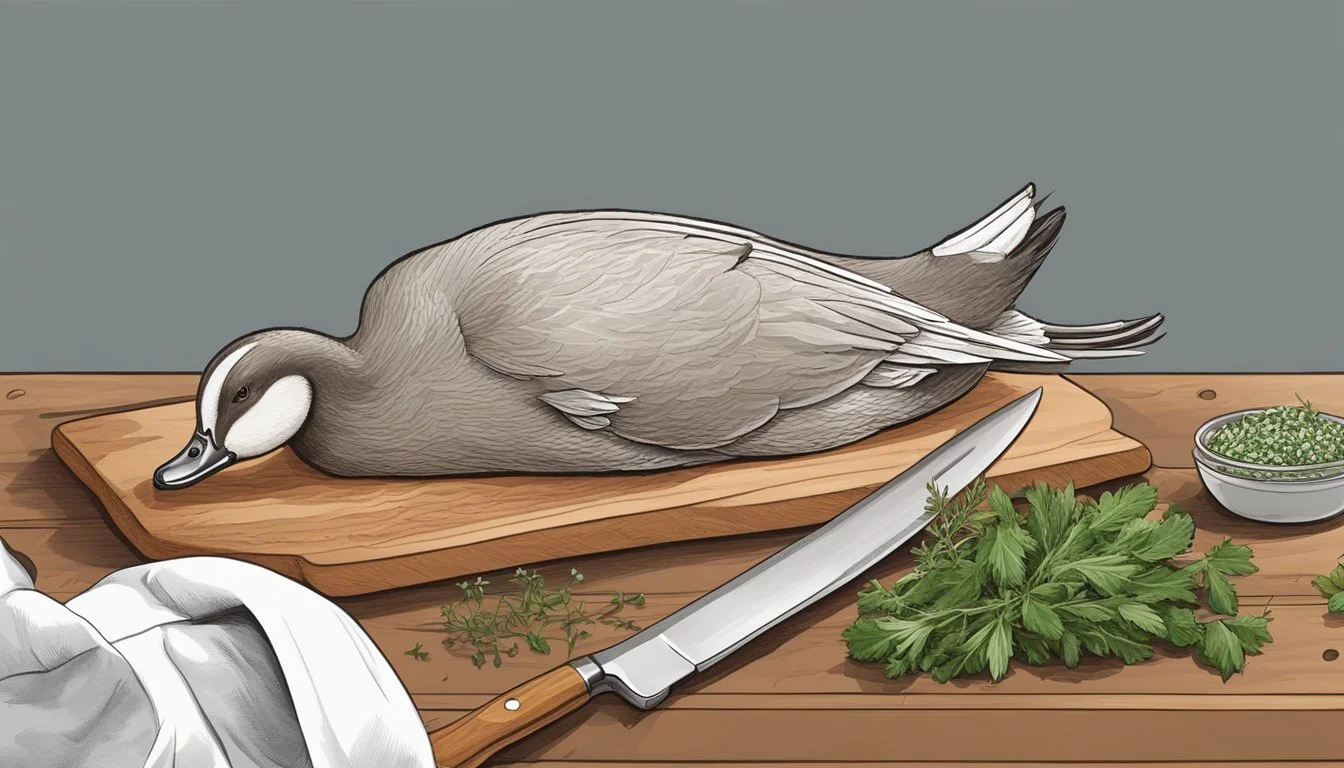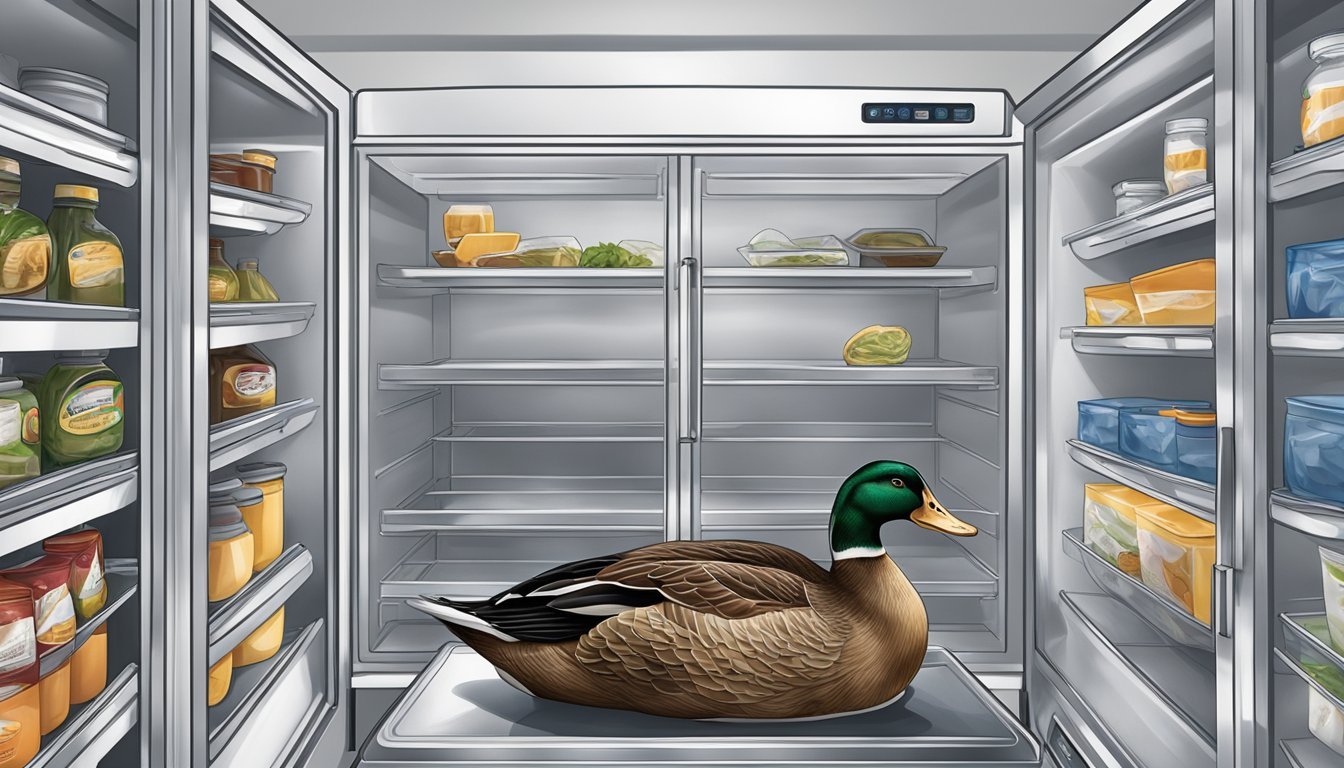How Long Does Duck Last?
Shelf Life and Storage Tips
When considering the shelf life of duck meat, it is important to understand the various factors that can affect its longevity. Like other poultry, duck has a finite period during which it is safe to consume. Proper nutrition and handling are critical in extending the shelf life of duck meat, ensuring it remains a healthy and enjoyable part of one's diet. The storage conditions are particularly crucial, with refrigeration being a key component to slowing down the spoilage process.
The typical refrigerator temperature, set below 40°F (4°C), will keep raw duck meat safe for consumption for approximately 1 to 2 days after purchase, as this temperature range hinders bacterial growth. If the duck is cooked, the shelf life extends to 3 to 4 days in the fridge, as the cooking process eliminates many of the bacteria present in raw meat. For those looking to store duck for a longer period, freezing is an efficient method, greatly extending its longevity up to six months while maintaining its quality, provided it is properly packaged and stored at 0°F (-18°C) or lower.
To maintain the nutritional integrity and taste of duck meat, it's vital to adhere to safe storage practices immediately after purchase. The importance of promptly refrigerating or freezing duck cannot be overstated, as it minimizes the risk of bacterial growth, ensuring the meat remains a nutritious and flavorful addition to meals.
Understanding Duck Meat
Understanding duck meat involves examining its nutritional value, the influence of duck breeds on meat quality, and how it compares to other types of poultry. Insights into these areas can guide both consumers and chefs in making informed decisions regarding its use in various culinary applications.
Nutritional Profile
Duck meat is well-known for its rich flavor and texture, attributed to its higher fat content compared to other poultry. The protein in duck meat is high-quality, essential for muscle growth and repair. Additionally, it contains omega-3 fatty acids, known for their health benefits, including anti-inflammatory properties. Here is a brief overview of its nutritional content:
Protein: Essential for bodily functions and muscle maintenance.
Fat: Duck meat has a higher fat content, particularly duck fat, which is prized for its flavor.
Omega-3 Fatty Acids: Beneficial for heart health and found in higher quantities in duck compared to other poultry.
Duck Breeds and Meat Quality
The quality and characteristics of duck meat can vary significantly depending on the breed. Three common breeds are:
Pekin Ducks: Known for their tender meat, they are the most popular breed in the United States and are often used in dishes like Peking duck.
Muscovy Ducks: They have less fat and a beefier flavor, making their meat desirable for specialized culinary uses.
Mallard Ducks: While less commonly farmed, wild mallards have a gamey flavor that can be appreciated in certain recipes.
The breed affects not only the flavor but also the texture and fat content, thus influencing its culinary uses.
Comparison With Other Poultry
When comparing duck meat to other poultry, such as chicken, several differences stand out. Duck is considered a type of red meat due to its darker color and has a richer flavor profile, which is a result of its higher fat content. Here, we compare duck with chicken, particularly in terms of meat and fat:
Duck Meat: Richer and more flavorful with a higher fat content.
Chicken Meat: Generally leaner with a milder taste. Chicken eggs are often compared with duck eggs, which are larger and contain more omega-3 fatty acids.
Duck Fat: It has a distinct, savory flavor and can be used in cooking much like white meat. (What wine goes well with white meat?)
The choice between duck and chicken largely depends on personal preference and dietary requirements, taking into account the distinctive taste and texture of duck.
Storing Duck Meat
Proper storage techniques are crucial for maintaining the freshness and safety of duck meat. Adhering to recommended practices for refrigeration and freezing ensures that duck remains of high quality and extends its shelf life while reducing the risk of spoilage.
Refrigeration Best Practices
Duck meat should be refrigerated as soon as possible after purchase or processing. It can safely stay in the refrigerator for 2 to 4 days. To maximize freshness, one should:
Place the duck in the coldest part of the refrigerator.
Store the meat in an airtight container or wrap it tightly with plastic wrap or foil to minimize exposure to air.
Freezing and Thawing Duck
For longer storage, freezing is effective:
Duck meat can be kept in the freezer for up to 6 months.
To freeze, one should wrap the meat tightly to prevent freezer burn and place it in an airtight container or freezer bag.
To thaw frozen duck:
The recommended method is thawing it in the refrigerator, ensuring a gradual temperature increase without compromising food safety.
One can also thaw duck in cold water or use a microwave if time is short, but these methods require the duck to be cooked immediately after thawing.
Shelf Life and Spoilage
Recognizing signs of spoilage is key to safety:
Typical indicators include a sour or off odor, slimy texture, and discoloration.
Duck meat should be cooked to an internal temperature of 165 degrees Fahrenheit to eliminate harmful bacteria, though some may prefer 180 degrees Fahrenheit for quality.
To sum up, adhering to these storage recommendations will help to maintain both the safety and quality of duck meat.
Health and Safety Considerations
Ensuring the health and safety of ducks empowers producers to provide safe, high-quality poultry products. This requires strict adherence to disease prevention practices, USDA guidelines, and safe cooking methods to avoid illness and ensure food safety.
Preventing Disease and Illness
To minimize disease and illness in ducks, producers must maintain clean habitats with adequate swimming water to prevent parasites and predators. A hygienic environment reduces the spread of diseases, and supervising water content keeps ducks healthy. Nutrition is also crucial; a balanced diet reinforces ducks' immune systems against potential ailments.
USDA Guidelines for Duck
The USDA sets regulations for duck processing to ensure safety and quality. Packaging must meet these standards, which involve correct labeling and the inclusion of safe handling instructions. Producers adhere to specific requirements to diminish the risks of contamination and spoilage, safeguarding consumer health.
Cooking to Safe Internal Temperatures
When cooking duck, one should achieve a safe internal temperature to eliminate harmful bacteria. According to food safety guidelines, duck should be cooked to an internal temperature of 165°F (74°C). Use a meat thermometer to verify that this temperature is reached in the thickest part of the meat, away from bone or fat, ensuring that the duck is safe to consume.
Breeding and Raising Ducks
Successful duck breeding and raising hinge on choosing the right breed for your objectives, creating optimal living conditions, and providing a balanced diet. Meeting these requirements ensures healthy growth and efficient meat or egg production.
Selecting Breeds for Meat Production
When selecting duck breeds for meat production, two popular choices standout: the Pekin duck and the Muscovy duck. The Pekin duck is known for its rapid growth rate, reaching market weight in just about 7 weeks, with a high yield of lean meat. On the other hand, Muscovy ducks mature more slowly but their meat is prized for its rich flavor and lower fat content. Another breed to consider is the Khaki Campbell duck, primarily for egg production, but also providing a good meat yield.
Housing and Environmental Requirements
Ducks require protective housing that shields them from predators and harsh weather conditions. Essential housing features include:
Ventilation: Sufficient airflow to prevent moisture buildup.
Space: At least 3-4 square feet per duck to allow comfortable movement.
Flooring: Dry, absorbent material to maintain cleanliness.
Access to water: Ducks need clean water not only for drinking but also for their characteristic dabbling behavior.
For environmental considerations, including a pond or a shallow water body can greatly enhance the wellbeing of ducks, although they can thrive without one as long as they have enough water to perform their natural behaviors.
Diet and Nutrition for Ducklings
Proper nutrition is crucial for duckling growth and development. Starting them on a waterfowl starter feed with 18-22% protein supports their rapid early growth. As ducklings transition to juvenile ducks around 2 months of age, their diet should adjust to a feed with a lower protein content of about 15%. Adequate grit should also be available to aid in digestion. For adult ducks, particularly layers such as the Khaki Campbell, a feed formulation of 16-17% protein is typically recommended.
Nutritional requirements differ slightly for meat production in breeds like Pekin ducks; they benefit from a higher protein content in their feed, ideally surpassing 20% for optimal growth rate and meat yield. Maintaining a balanced diet is key to healthy ducks and successful breeding and raising operations.
Eggs and Egg Production
Duck eggs are a nutritious staple in many diets with distinct differences from chicken eggs. They have a higher nutritional value but also contain more cholesterol. Understanding these differences, alongside effective management of egg laying and optimal storage practices, ensures the full utilization of duck eggs.
Comparison with Chicken Eggs
Duck eggs are nutritionally rich, known for their larger size and thicker shell compared to chicken eggs. They typically contain more protein, vitamins, and minerals but also have higher cholesterol levels. A key difference is the higher amount of omega-3 fatty acids found in duck eggs, which contribute to cardiovascular health.
Managing Egg Laying and Collection
Female ducks have varying egg-laying capabilities, often influenced by their breed. For instance, Khaki Campbell ducks can lay between 250-340 eggs annually, while Welsh Harlequin ducks lay around 150-330 eggs per year. Ducks usually lay eggs in the early morning hours. Egg collection is most efficient when done early in the day to ensure the eggs' cleanliness and to reduce the risk of predation.
Storage and Lifespan of Duck Eggs
The shelf life of duck eggs can be maximized with proper storage. When stored in a refrigerator, duck eggs can last for several weeks. The freshness test involves placing eggs in water: fresh eggs will sink and lay on their sides; eggs standing on end are older; floating eggs indicate they have gone bad and should be discarded. Always store them in a cool, dry place, preferably in the refrigerator, to extend their lifespan.
Predators and Pest Management
The survival of ducks, both in the wild and in domestic settings, is significantly influenced by the threat of predation. Effective pest control strategies are vital for protecting ducks from common predators.
Common Predators of Ducks
Mammals: Foxes, raccoons, and even domestic dogs pose a serious risk to ducks. These predators often hunt at night and can decimate duck populations if not deterred.
Birds: Eagles, hawks, and other large birds of prey target ducklings and at times adult ducks.
Reptiles: Snakes and alligators, where present, can be opportunistic predators of ducks.
Other: Snapping turtles also prey on ducklings in aquatic environments.
Pest Control Strategies
Enclosures: Providing secure housing is essential for ducks to evade nocturnal predators. Enclosures should be well-ventilated and fortified against intrusion.
Pond Design: Strategic pond designs with steep sides can deter predators, making it difficult for them to access ducklings in the water.
Guard Animals: Using animals such as geese, dogs, or even llamas as guard animals has proven effective in warding off potential predators.
Ensuring Safety from Predation
Surveillance: Regular monitoring of the duck habitats can identify potential security breaches and predator patterns.
Maintenance: Repairing fences, secure coop latches, and eliminating cover for predators reduces the risk of duck predation.
These practices help to safeguard ducks from predators and ensure that they live out their natural lifespan.
Lifespan of Ducks
The lifespan of ducks varies significantly between wild and domestic environments. In the wild, ducks have a general lifespan ranging from 5 to 10 years depending largely on the species and environmental hazards. For example, mallard ducks, which are common in the wild, may live between 3 and 5 years due to predation and habitat challenges.
Domestic ducks, on the other hand, can enjoy a longer life due to controlled environments, healthcare, and nutrition. Typically, domesticated ducks may live for up to 20 years or more.
Mallard Duck: In the wild, 3-5 years; domesticated up to 20 years.
Khaki Campbell: Often lives 8-10 years, with some reports of up to 15 years.
Indian Runner: Known to live 8-12 years in domesticity.
Bantam Ducks: These smaller ducks can live from 10 to 12 years, one of the longer expectations among domestic breeds.
It's noteworthy that the Guinness Book of World Records cites the longest living ducks reaching 49 years, although this is an extraordinary exception.
In wilder settings, ducks face numerous challenges such as predators, disease, and environmental stressors which significantly reduce their average lifespan. Domestic ducks benefit from protective measures against such risks, which accounts for their extended longevity.
Duck Breed Wild Lifespan Domestic Lifespan Mallard Duck 3-5 years Up to 20 years Khaki Campbell - 8-15 years Indian Runner - 8-12 years Bantam Ducks - 10-12 years
By ensuring good husbandry practices, owners of domestic ducks can aspire to help their ducks reach the upper limits of these average life expectancies.








